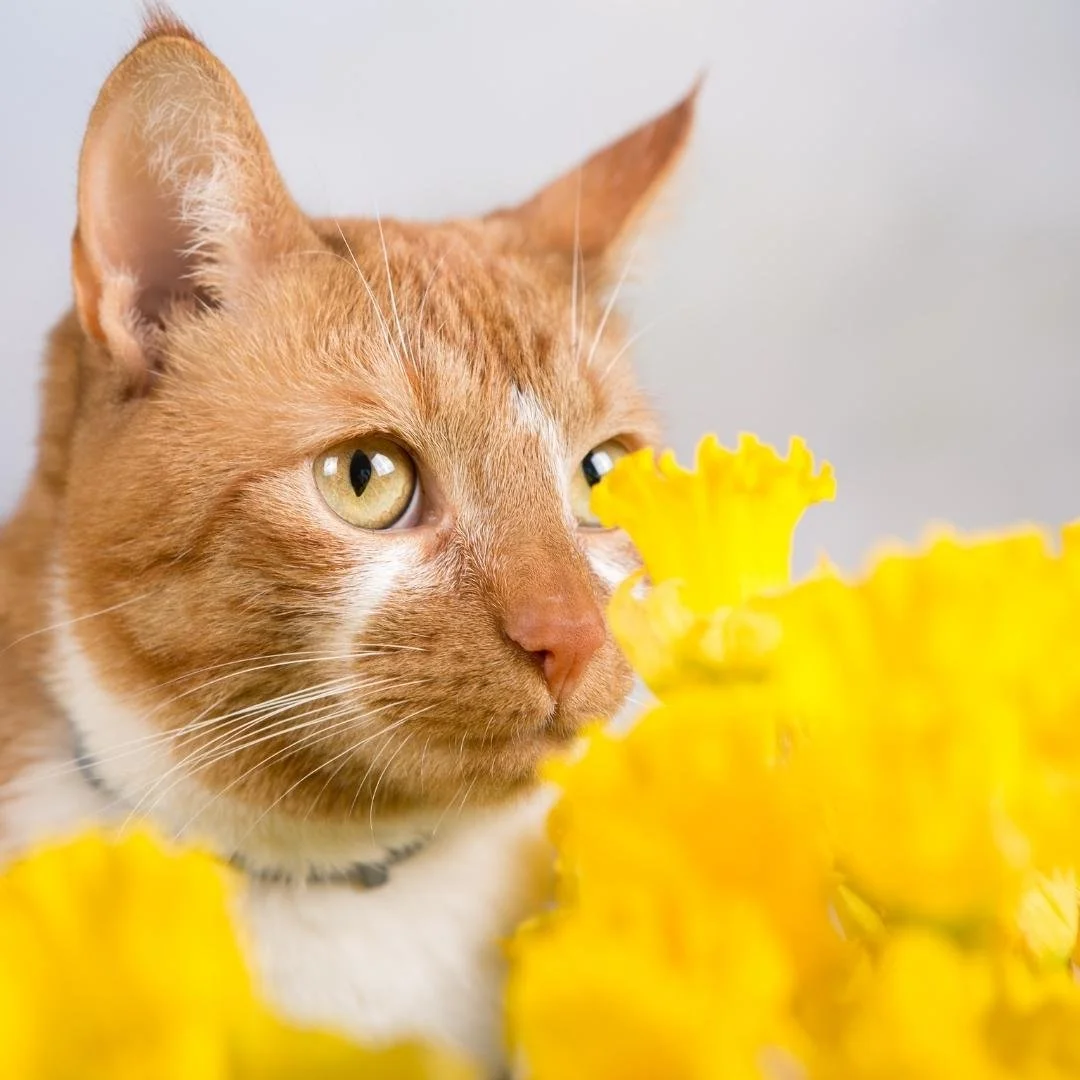Spring precautions for your pet
The spring season means the arrival of warmer weather, longer days, and more time spent outdoors.
However, just like with other seasonal changes the changes into spring, there are a few extra precautions you should keep in mind for your pet to keep them safe and healthy throughout the spring months.
Young cat or dog that is unneutered may be coming into season.
Cats:
As the days start to lengthen towards spring times, female cats respond by starting to come into season. This means that they are attractive to tom cats and are able to become pregnant.
Signs to watch for: Signs include being very vocal, flicking their tails in the air and pushing their bottoms upwards while playing. You may see or hear other cats around the property when your cat is in season, but this is not always the case – just because you can’t see or hear it, doesn’t mean it isn’t happening.
Young female cats can have a first season as young as four months old and are able to get pregnant also at this early age.
This “on-heat” behaviour will last for an average of seven days and will be repeated every 7-21 days if no mating takes place. These seasons will occur right through the breeding season until the autumn, if she is not speyed (de-sexed).
There are many reasons that speying your female cat makes sense
It prevents unwanted pregnancies and unwanted kittens in often, very young mothers. It also prevents the spread of some of the nastier feline viruses such as feline leukaemia virus, that may be passes on during birth or nursing.
For female cats, desexing is generally recommended at 6 months old. This can be brought forward very slightly at the vet’s discretion if circumstances mean there is a higher chance of the cat mating or being mated before the age of 6 months.
This is a day trip for them with a morning drop off and afternoon pick up. Cats that are currently in season or have an early pregnancy can also be speyed. This stops any seasonal behaviour and unwanted toms hanging around. It is definitely recommended as part of responsible cat ownership!
If you have any questions regarding feline de-sexing or want to book in a spey please contact one of our clinics for help and advice.
Dogs:
By desexing your pet, many unwanted litters are prevented. It is a one-off procedure that usually only requires a day stay in hospital.
Desexed males will not get testicular cancer, are far less likely to have behavioural issues and have a reduced incidence of prostate disease compared to their entire counterparts.
Desexed females will not get diseases of the ovaries or uterus and if done early enough will reduce their risks of developing breast cancer. The only true disadvantage of surgical desexing, is that you will not be able to breed from your pet.
Bee stings.
Poor Mila had an encounter with a bee. After visiting the clinic, she made a full recovery.
Just like people, pets can have allergic reactions to bites and stings. Although the risk of bee stings is present year-round, spring and summer bees are more active.
If your pet has been stung, you might see bumps, swelling of the skin, itchiness, and even in severe cases vomiting or drowsiness.
In cases where your pet is showing signs of distress from a sting, they really need to be checked out by the vet as soon as possible.
For severe swellings, or if your pet is very distressed, the vet can prescribe an antihistamine or a steroid which can help to alleviate the effects of the sting.
Spring Flowers.
Cats and dogs enjoy spending time outside in the garden or park. During the spring months keep a watch out for poisonous plants while they enjoy these activities. During the spring months common toxic plants to look out for include lilies, daffodils and azaleas. Daffodils can be toxic, particularly the bulbs, however, the flower heads can also cause vomiting, diarrhoea, and lethargy. In severe cases this may result in dehydration, tremors, and convulsions. These signs can be seen from 15 minutes to one day following ingestion.
Although bluebells are uncommon in New Zealand, all parts of the plant are toxic to dogs. If ingested it can cause vomiting, diarrhoea, and abdominal discomfort. A significant quantity of bluebell ingestion can also cause a risk of heartbeat irregularity (arrhythmia).
Other spring flowers to be keep a look out for include tulips and crocuses. They are less toxic, however seek advice from your vet if you are concerned your pet has eaten them.
Barbecues (onions, garlic, bones).
The warmer weather during the spring months often leads to the start of barbecue weather. If you are having a barbecue, keep your cat and dog at a safe distance. Ingredients from a barbeque can be dangerous to your pet if it is within their access.
Fresh, dried or powdered garlic and onions can cause a stomach upset and anaemia (low red blood cell count). The anaemia is caused by the destruction of red blood cells which in turn results in the reduced ability of the blood to carry oxygen to the organs that need it. In severe cases, the anaemia may lead to internal organ damage or even death. This toxicity is from the Allium species of plant which includes garlic, onions, leeks, scallions, chives and shallots.
If you suspect your pet has ingested these, watch for the following signs and contact your vet straight away:
rapid heart rate and breathing rate
weakness or lethargy
vomiting and diarrhoea
pale gums
red or dark coloured urine
jaundice (seen as yellowing of the gums , skin and white parts of the eyes)
Sweetcorn itself is not toxic – lots of dogs (and some cats!) love the odd little bit. However, the danger occurs with corn on the cob. When a corn cob is eaten by a dog, it is just the right size to cause a serious intestinal blockage. It is one of the most common foreign bodies we encounter. Please dispose of your corn cobs sensibly and ensure your dog is not given any.
Allergies.
Just like people your cat or dog can develop allergies to plants, pollens, grasses, and other materials. These substances are often in abundance during the spring months. Allergies in pets normally appear as itchy skin and ear problems, accompanied by hair loss or inflamed skin.
Some pet’s experience behavioural changes due to the irritation the allergies bring. If you notice any of these symptoms with your pet seek veterinary advice.
Medication.
During the spring to early summer months owners who suffer from seasonal allergies are likely to be stocking up and using antihistamine medication. Ensure you keep these medications our of reach from your dog – they can be toxic. Signs of ingestions includes:
Vomiting
Lethargy
Incoordination
Wobbliness
And tremors
Symptoms will typically develop within four to seven hours after ingestion. If large amounts of anti-histamine have been ingested convulsions, respiratory distress and coma may occur.
If you notice any of these symptoms with your pet seek veterinary advice as soon as possible.
Barley grass, foxtail awns, and bidi bidi seeds.
During the late spring months barley grass, foxtail awns and bidi bidi seeds are abundant. They stick to fur; barley grass and foxtail awns can pass easily through the skin. They are capable of invading your dog or cats’ body through the feet, ears, eyes, mouth, or any body surface.
Grass seeds are designed to catch and hold, being arrow-like with small barbs. The barbs prevent them falling off a pet’s hair or skin and also mean that each movement of the body can drive the seed deeper into fur, tissues or cavities. If they enter the abdomen or chest cavities the effects can be potentially fatal. In the eye, barbs cause ulcers, and in the ears, they may rupture the ear drum.
Prevention is key!
Prevention is better than cure when it comes to grass seeds. Keep your pet groomed (especially feet and ears) and your lawns short. Do not let your dog play in the long, unkept grass at the edge of parks and by streams etc. during seed season. Check all feet, ears and the coat after each walk. Contact your vet for advice whenever you see any of the following symptoms:
Toes, feet and skin: Swelling of the skin, limping, weepy hole, excessive licking/chewing
Ears: Head shaking/scratching, an ear which is painful to touch, yelping.
Eyes: Rubbing eye/squinting, swollen eyelids or discharge.
Fur: Matting.
Nose: Sneezing, nasal discharge, pawing at nose, difficulty breathing.
IF YOU SUSPECT your dog has a barley grass we advise you to seek immediate veterinary attention due to the potential complications of leaving barley grass untreated.
Bidi Bidis can get stuck in your pet’s fur and cause painful matting in their coat. Before bidi bidi season starts get your pet’s coat clipped and brushes and regularly check their coat for the seeds.
Fireworks season.
The latter part of spring marks a start to the firework season, especially around Guy Fawkes night.
Fireworks season can be difficult for pets with a sound sensitivity; their anxiety levels rise in anticipation of fireworks as they can associate changes in seasons with an event. As pets will start to become increasingly anxious about fireworks, you need to start thinking and planning for this annual event in advance.
There are a few fundamentals that you can prepare in advance which will help your pet through a stressful event such as fireworks or parties.
Provide a den
An important step is to ensure your pet has a safe haven or den to retreat to; an area that they feel secure in. Ideally this should be in an internal room that is easily accessible and away from windows.
Use Adaptil or Feliway
The use of Adaptil ® (a synthetic copy of the dog appeasing pheromone) has been shown to reduce anxiety and help dogs cope with challenging situations, including firework events, as demonstrated by scientific studies. Also available for cats is Feliway ®.












